 |
 The Happy Daylily Blog - daylily pictures and thoughts from my garden
The Happy Daylily Blog - daylily pictures and thoughts from my garden

|
 March 19th, 2020 March 19th, 2020 |
Today I had my first bloom of the season. This year's FBO seedling was also the first to bloom last year but it was a couple of weeks earlier this year. Unfortunately the bloom wasn't worth taking a picture so the picture below is a different daylily. Today's bloom was too close to another scape preventing it from opening properly. Maybe better luck tomorrow as I should have another bloom.
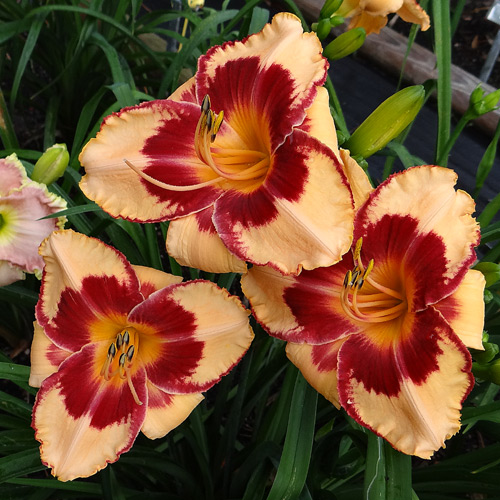
Seedling 16-127
Seedling 16-127 made it to the evaluation bed by virtue of an available space. The bloom had a decent presence in the garden but the bud count was low on 35" scapes (not a promising combination). I was sure it would probably be discarded after a year or so but it turned out to have a redeeming value after all. It multiplies very well so it puts up quite a few scapes plus it reblooms a couple of times. This keeps it in bloom for an extended period of time something always welcome in the daylily garden. It has 5.5" blooms and comes from the cross (What Fun X (Orange City x Caribbean Magic)).
|
 March 17th, 2020 March 17th, 2020 |
24 hours after the aphid treatment and the little beasties are all gone. Nothing left but a few dead ones and a bunch of empty skins from their moults. That's good because when left unchecked they can suck all the life juices out of all the emerging new foliage from every fan in the garden. The aphid life cycle is more interesting than I had expected. A little research turned up the following info:
During most of the year, aphids are all female and wingless. They reproduce by giving birth to live nymphs as opposed to laying eggs. The nymphs moult several times as they mature leaving their skins behind (the stuff that looks kinda like bad dandruff). In a little over a week the nymphs mature into adults and begin producing their own nymphs. This rapid development is why so many aphids seem to appear suddenly in the daylily garden. In the fall, some of the numphs develop wings and fly to another food plant (in my case, probably another daylily). These winged aphids are both male and female. After mating, the female lays eggs which can survive the winter. In the spring the eggs hatch into females starting the process all over again.
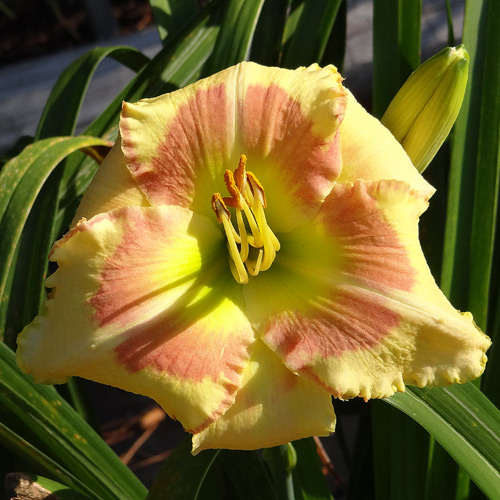
Seedling 14-061
Seedling 14-061 has 5.5" blooms on 27" scapes. It comes from the cross (Sunshine Kisses X Sir Francis Drake).
|
 March 16th, 2020 March 16th, 2020 |
My order for Bonide Systemic Insecticide arrived yesterday so this morning I sprayed to eliminate the aphids. I figured I was going through the motions so I might as well spray for rust at the same time. For this rust rotation I used Honor Guard. Honor Guard contains the same fungicide as Banner-Max.
Bloom season is fast approaching. I estimate that about 15% of my daylilies already have scapes and the first bloom is only a few days away.
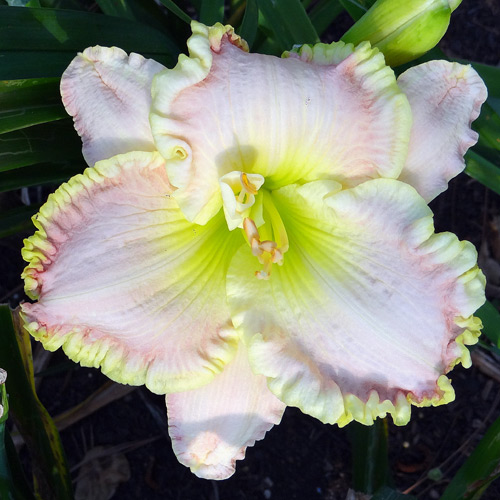
Seedling 15-096
Today's image is seedling 15-096. It has 7" blooms on 21" scapes and comes from the cross ((Victorian Lace x J.T.Davis) X Voila Francois).
|
 March 13th, 2020 March 13th, 2020 |
A few days ago I discovered that aphids were starting to make a comeback. I got out the sprayer but uh-oh. Apparently I used the last of my Bonide Systemic insectide with my last spraying and failed to get more. I usually buy it at the local 'big box' hardware store so off I went. Nope... neither of the big box stores seem to carry it any longer. I didn't have time to hunt it down so I ordered it online. It's scheduled to arrive this weekend.
I now have between 12 and 15 different daylilies with scapes. Time to get the camera charged and checked out (smile).
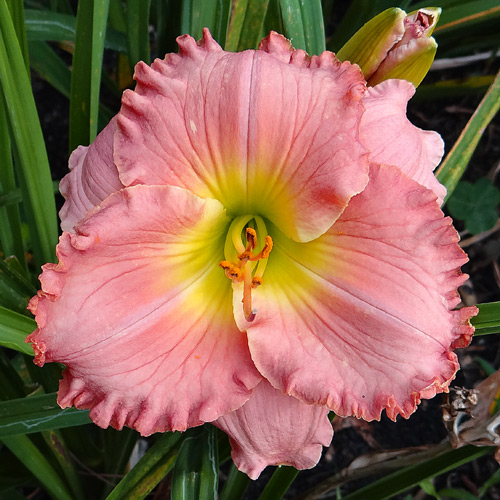
Seedling 08-014
Seedling 08-014 is another that I continue to grow for my own enjoyment. I really like the round ruffled form. It makes robust plants and sturdy 23" scapes but the bud count has never been all that great. The blooms are 6" and it comes from the cross (Catalina Kiss X Ruffled Masterwork).
|
 March 7th, 2020 March 7th, 2020 |
Usually, I wait until the soil warms up before giving the daylilies their "spring tonic". The reason for this is that one of the main ingredients is something to increase the beneficial micro-organisms in the soil (I like to use Garrett Juice). It's my belief that if the soil is still quite cool the micro-organisms won't multiply very well in cool soil and that defeats the purpose. The other important ingredient is Epsom Salts. There are several well documented benefits to using Epsom Salts in the garden. In addition, I was told many years ago that Epsom Salts make bloom colors more vivid. I can't confirm the color thing but for all the other reasons it's worth the effort.
This year with scapes starting so early, it occurred to me that waiting for warmer days to apply Epsom Salts might mean the plants might not have time to take advantage of the application when it comes to improving bloom color. Epsom Salts can be applied at any time so I decided to apply that part of my spring tonic today. I dissolved 1/4 cup Epsom Salts in a 5-gal bucket and mixed in a little liquid humus. I poured about 3 cups in the middle of each clump. Yes, that meant mixing and toting lots of 5-gal buckets around the yard. I should mention that yesterday I gave the garden a quick watering so the soil surface wouldn't be dry. This allows the Epsom Salts mixture to easily soak into the soil and not run off the surface.
I still plan to apply the micro-organism part of the tonic when the weather gets warmer.
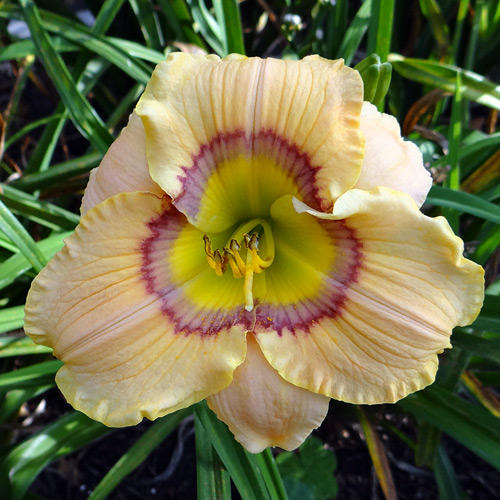
Seedling 04-003
Seedling 04-003 is another that I've grown for many years. It doesn't have an edge but I like the narrow etched eye and deep green throat. It has 5.5" blooms on 27" scapes and comes from the cross (Faces of a Clown X Unknown).
|
 March 5th, 2020 March 5th, 2020 |
I found a scape on another seedling today. I also found a scape on Hedwig's Eyes. Hedwig's Eyes always blooms early but it's going to be earlier than usual this year.
A few days ago I replaced the pump on my Hot-Shot sprayer. I've had the sprayer many years and about every 4-5 years I have to replace the pump. I think what happens is the rubber on the diaphram becomes less flexible with age and eventually tears. The first time I changed out the pump it probably took me about 6 hours - I had no clue what I was doing. Now with a few changes under my belt I'm able to change it out in just over an hour. Changing the pump is a pain but it's much cheaper than buying a whole new sprayer.
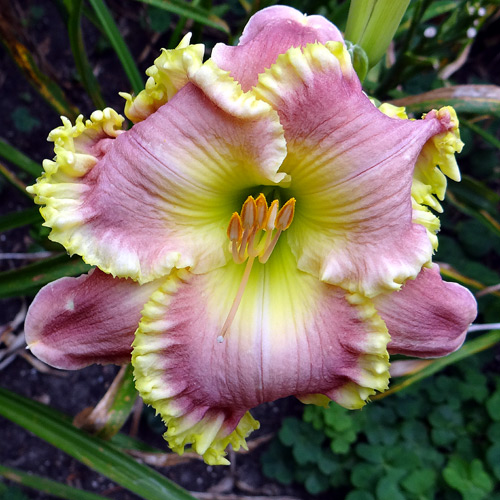
Seedling 14-006
Seedling 14-006 has 6" blooms on 28" scapes and comes from the cross (What Love Can Do X Emerald Bay).
|
 March 2nd, 2020 March 2nd, 2020 |
I HAVE SCAPES! Today I was bringing in groceries and there they were... the first scapes of the 2020 season. There were 3 of them on a seedling which always tends to be early. Last year the first scapes didn't show until March 17th so unless we get a prolonged cold spell, bloom season could start early this year. I can HARDLY WAIT for things to start popping in the garden (smile).

Seedling 16-069
Today's image is seedling 16-069. I like the colors but so far the bloom substance has been disappointing. This could be the make-or-break year for this seedling. It has 6" blooms on 26" scapes and comes from the cross (Unspoken Love X (Exotic Treasure x (Hedwig's Eyes x Spacecoast Gold Bonanza))).
|
 February 29th, 2020 February 29th, 2020 |
The front yard daylily beds are filling up with Oxalis as they do every year at this time. The leaf mulch will help enrich the soil but it makes weeding more difficult. However I'm sure you don't want to read about boring weeding so I'll just post another picture.
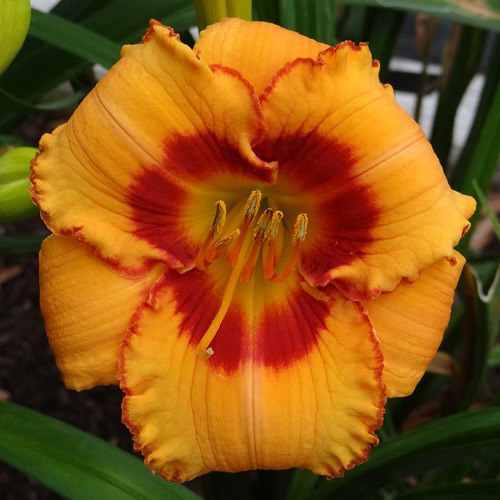
Seedling 14-012
Seedling 14-012 is another of the seedlings that I've kept because of good overall performance. It doesn't have what could be called a 'knockout' bloom but the colors are clean and bold and it consistently opens well. It has 5" blooms on 32" scapes and the bud count is in the mid 30's. It comes from the cross (what Fun X Bella Vita).
|
 February 23rd, 2020 February 23rd, 2020 |
This time of year is just a waiting game. The daylilies are huge and look like they could put out scapes any day now but I know it's still too early. Actually, I prefer they don't start blooming too early as the best blooms come in May when the nights are warm and the days are hot (but not blazing hot). I continue to spray for rust about every 10-12 days. That's a little longer than what's recommended (every 7-10 days) but it keeps the majority of the daylilies rust free.
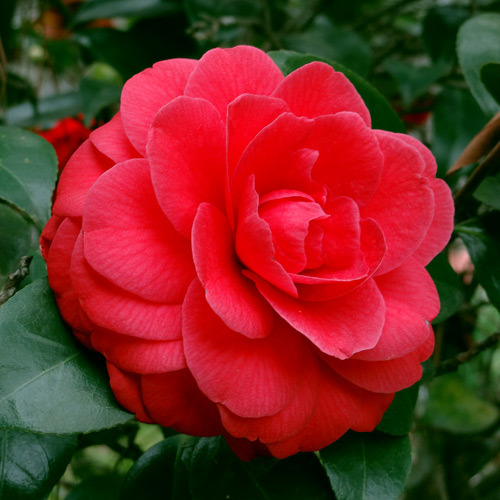
Camelia
My Camelia blooms are looking good this year so I thought I'd post a pic.
|
 February 16th, 2020 February 16th, 2020 |
Not much to report daylily-wise as I've been concentrating on building my backyard patio. This morning I finished laying the pavers so the hard work is now done. The patio includes some enclosed flower beds and that's what I'll work on next.
As they say, spring is busting out all over. Oak trees have begun putting out new leaves, birds which haven't been seen during December and January are starting to arrive, and Camelia and Tulip tree blooms are underway. I find myself itching to apply my spring daylily elixer but I know it's too early. The elixer includes benefical microbes and the soil is still way too cool for them to increase to a meaniful degree. I'll have to force myself to wait awhile longer (sigh)... I'll post my recipe at that time.
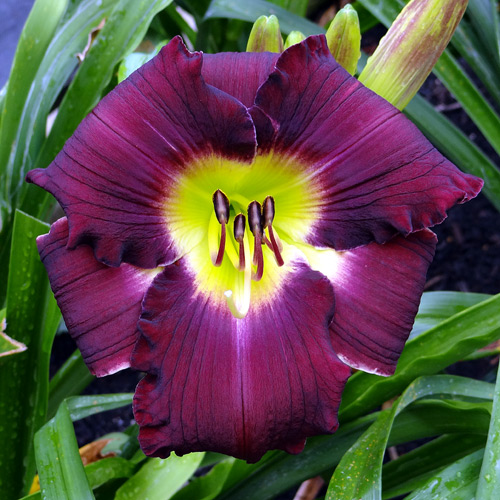
Seedling 00-048
Seedling 00-048 is the oldest seedling in my garden. It first bloomed 20 years ago this year. That was during my 'purple period' when I tried concentrating on hybridizing purples. I have kept it all these years because it has such good color and performs well. I never considered registering it because it didn't have an edge and edges have always been my focus. I probably should reconsider. It has 5.5" blooms on 28" scapes with a bud count in the mid 20's.
|
 February 10th, 2020 February 10th, 2020 |
Having lots of different daylilies and a relatively small amount of space has always made it pretty much impossible to keep the garden organized efficiently. New daylilies would be purchased and that meant that something from the garden had to go. It was always something that was either underperforming or something that I was no longer using in my hybridizing. Out it would go and the new daylily was planted in the just vacated space. To complicate matters, the plants were already spaced close together so I could fit in the maximum number of plants in each bed and no accommodation was given for large plants vs. small plants. This resulted in a hodge-podge with conflicting colors next to each other and small foliage daylilies next to huge foliage producers. I'm now beginning the process of selectively eliminating some of the poorer performing seedlings to give me more room to spread the plants out.
This morning, I walked the garden and made a list of all daylilies with foliage of 30" or more. These are the ones that will need more room. Separating the robust foliage plants from the smaller foliage plants will allow me to avoid smaller plants being shaded by larger plants. Another advantage to increasing the spacing between plants is that air flow will be better which will allow the foliage to dry out quicker (rust thrives in wet conditions).
I chose this time to make my list as foliage is approaching "maximum lushness". I'll add this data to my database so it will be available next fall when I rework the beds again. It may take a couple of years or more to get everything rearranged the way I want it but the result should be a better looking and performing garden.

Seedling 15-015
Today's image is seedling 15-015. It has 6" blooms on 32" scapes and comes from the cross (Sunshine Kisses X Fashion Police).
|
 January 27th, 2020 January 27th, 2020 |
This morning I sprayed again for rust. I currently have only a little rust on a handful of cultivars but generally the garden looks pretty clean. While spraying, I was contemplating some of the statements I've read and heard about how other people handle rust. A couple of local daylily growers have said they 'top' their daylilies during the winter. This removes much of the older foliage which is the foliage that always seems to show the most rust. After the new foliage has grown out their gardens show little rust but they admit this only delays the onset of rust. This begs the question of which is best for overall daylily blooming: topping and spraying when rust begins to appear or just spraying based on the calendar to try and prevent rust. Questions, questions, questions... (smile).
I was amazed to see how much the foliage has grown in the past 12 days since I previously sprayed. Last time it took about 10 gallons to spray all the gardens while today took 14 gallons. There's just a lot more foliage to cover and that's a good thing!

Seedling 15-049
When seedling 15-049 first bloomed I thought it was pretty unremarkable. Eventually, I realized that although unremarkable, this was a bi-tone daylily, something that has been fairly rare in my garden. It has 5.5" blooms on 28" scapes and comes from the cross (Dragon Knife X Bella Vita), neither of which were bi-tones. It has a decent bud count so I decided to keep it to see what it might do.
|
 January 21st, 2020 January 21st, 2020 |
Today I finally finished weeding and mulching all my daylilies. The final tally turned out to be about 55 bags of leaves to do all the beds. It will probably take about a year or so before I can pass judgement on whether or not this project was worth the effort. When I dig/divide next fall I'll be able to see if the soil has improved. Most of the feedback I've received has been quite positive with several indicating they had used leaves for mulch for years and the soil was full of fat earthworms.

Seedling 16-004
This is seedling 16-004. It has 5" blooms on 20" scapes and comes from the cross (Violet Stained Glass X Serengeti Sunrise).
|
 January 16th, 2020 January 16th, 2020 |
As expected, aphids made their appearance in my garden. I had been checking the new growth on random fans and a couple of days ago I spotted the first few of the little green buggers. So yesterday I sprayed with Bonide Systemic Insectide which should not only eliminate the current population but also prevent a new infestation for about 30 days. While I was at it, I also sprayed for rust.
The weather recently has been mild temperatures, high humidity, and fog. This results in wet foliage for many hours, perfect for both rust and aphids.
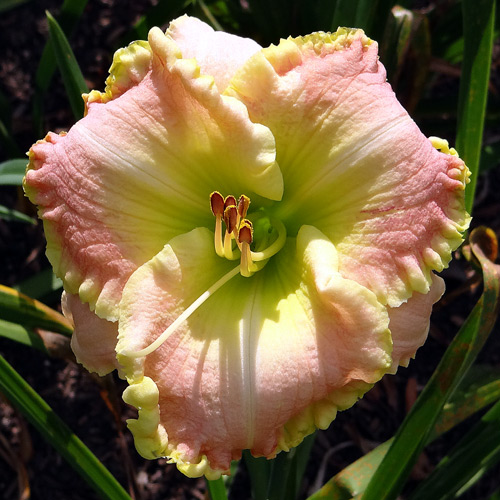
Seedling 14-083
Today's image is seedling 14-083. It has 6" blooms on 27" scapes and comes from the cross (Cimarron Rose X Priscilla's Smile). The resulting color was somewhat unexpected as this cross usually produced rosy-purple to purple seedlings.
|
 January 12th, 2020 January 12th, 2020 |
Yesterday the Houston Hemerocallis Society held a "daylily dig" at one of the club member gardens. We dug/divided daylilies for several hours potting up the excess fans for the club's upcoming spring sale. We had a picnic lunch (hot dogs cooked over the grill of course) and everyone had a great time.
I highly recommend if you do not already belong to a local daylily club, that you find one and join. To find a local club in your area go to the American Daylily Society website. Under the 'Society' tab select 'Regions' (be patient, it's sometimes a little slow to respond). Using the map of US & Canada on the region page, click on your state to select your region. Then you can scroll down to see a list of local societies by state.

Seedling 14-035
This is seedling 14-035. It has 5" blooms on 23" scapes and comes from the cross (Always Baroque X Edwardian Charm). It bloomed nicely this past season putting up 3 sets of scapes.
|
 January 6th, 2020 January 6th, 2020 |
Somewhere between December 15th and January 15, aphids usually make their spring appearance. So yesterday as I was preparing to spray for rust, I decided to check the garden for aphids. To my surprise, I didn't find any. It probably won't be long before they arrive however as I saw a ladybug in the garden today.
The daylily foliage is looking great with the more robust cultivars already showing off big fat fans. Most of the cultivars I divided in the past couple of months haven't done much but I know they are busy re-establishing their root systems and as the weather begins to warm they too will take off.
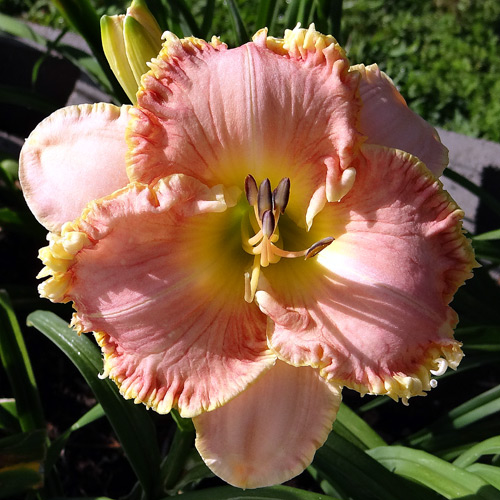
Seedling 16-125
Today's image is seedling 16-125. It has 6" blooms on 34" scapes and comes from the cross (Celtic Moonglow X Barefoot Bay).
|
Previous Posts
 Back to current posts
Back to current posts
|

 March 19th, 2020
March 19th, 2020 March 17th, 2020
March 17th, 2020 March 16th, 2020
March 16th, 2020 March 13th, 2020
March 13th, 2020 March 7th, 2020
March 7th, 2020 March 5th, 2020
March 5th, 2020 March 2nd, 2020
March 2nd, 2020 February 29th, 2020
February 29th, 2020 February 23rd, 2020
February 23rd, 2020 February 16th, 2020
February 16th, 2020 February 10th, 2020
February 10th, 2020 January 27th, 2020
January 27th, 2020 January 21st, 2020
January 21st, 2020 January 16th, 2020
January 16th, 2020 January 12th, 2020
January 12th, 2020 January 6th, 2020
January 6th, 2020 Back to current posts
Back to current posts














